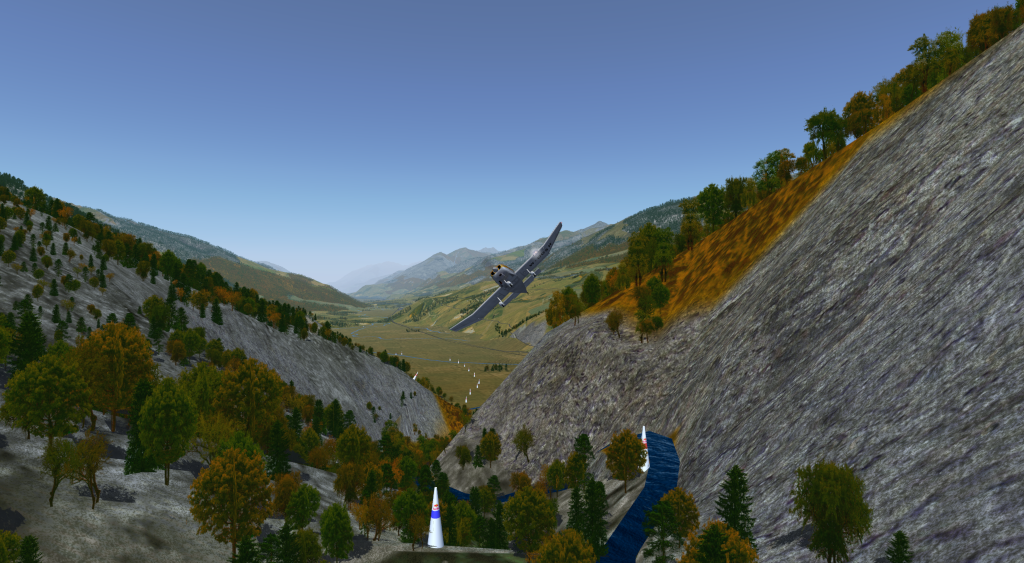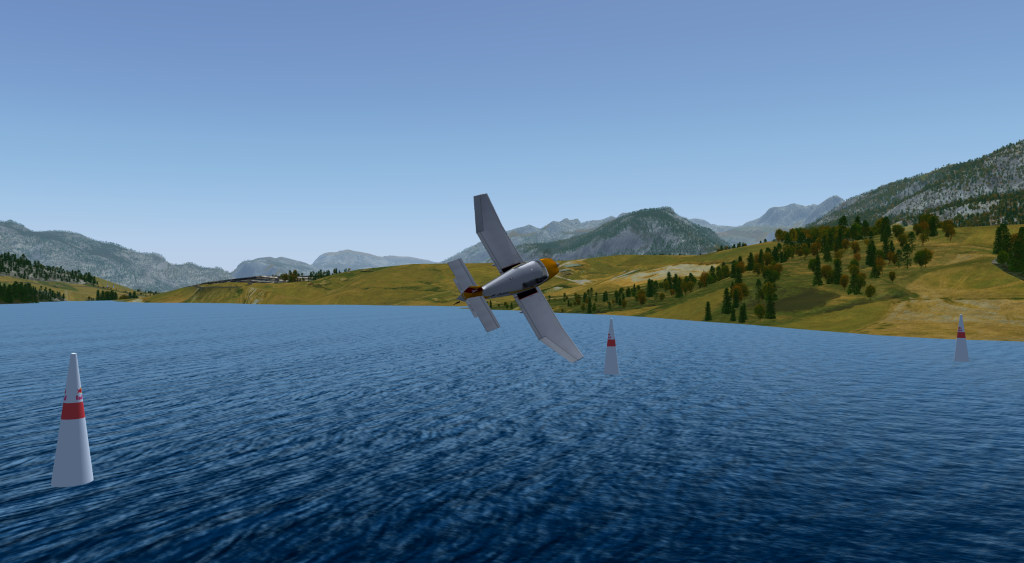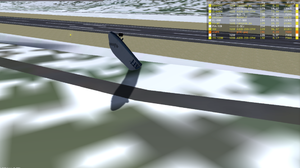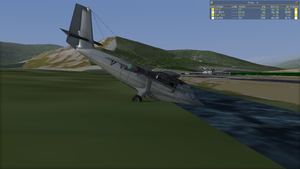User:LoCall/LILO-LOWI-Adrenaline: Difference between revisions
Jump to navigation
Jump to search
No edit summary |
No edit summary |
||
| (29 intermediate revisions by the same user not shown) | |||
| Line 9: | Line 9: | ||
<br /> | <br /> | ||
''' | '''Intro - Where it all have Started''' | ||
The beginning is always a delicate matter. | The beginning is always a delicate matter. | ||
| Line 15: | Line 15: | ||
This has been true for this writing... | This has been true for this writing... | ||
It has been true for the creation of the LILO-LOWI-Adrenaline "parcours" ... | It has been true for the creation of the LILO-LOWI-Adrenaline "parcours" ... | ||
and it is a painful truth for all the pilots debuting and struggling with their plane. | and it is a painful truth for all the pilots debuting and struggling with their plane. | ||
We all have been at that very start point, | We all have been at that very start point, is it not ? | ||
Trying to land in a satisfying manner, failing, and trying again, repeatedly. | |||
CFIT(Controlled Flight Into Terrain) on final approach, bumpy landing, complicating | |||
with Tortoise oscillations(1), Runway Excursions, are quite constant. | |||
[[File:RWY-Excursion at VQPR-292-978×549.png|978x549|frameless|Excursion at Paro (Buthan)]] [[File:800_Thirsty_Horses_-_screen-009.png|978x549|frameless|Missed Taxiway]] | [[File:RWY-Excursion at VQPR-292-978×549.png|978x549|frameless|Excursion at Paro (Buthan)]] [[File:800_Thirsty_Horses_-_screen-009.png|978x549|frameless|Missed Taxiway]] | ||
| Line 29: | Line 32: | ||
'''Wrong Mind - Wrong Landing''' | '''Wrong Mind - Wrong Landing''' | ||
- "...oh, it is just a simulator... With a bit of training, we should get there..." | |||
- "...oh, it is just a simulator... | |||
My best will and patience was there but something else was missing. | |||
To be honest, results was way to be satisfying. | |||
Actually, It was not "getting there" at all ! | |||
Flightgear community is really amazing, several users come spontaneously to help me. | |||
Suggestions, advises and demonstrations have come to be handy. It has allowed me to | |||
review my techniques and improve my skills. | |||
I am grateful for all the care and time theses users spent on me. | |||
I | But without putting any word in contrariwise, I was still needing to understand the | ||
why... | |||
I was needing to understand how it does really and exactly work in order to not be | |||
forced to rely on buttons (ILS) and approximations in order to do a good landing. | |||
'''Never give up!''' | |||
I did not give up. | |||
Successive tries with, at each time, modified flying configuration, weather, weight | |||
have led me to new questions and new search criteria. | |||
Surely per chance, I have found an amazing explanation given by a retired flight | |||
instructor. | |||
The amazing part was in the great simplicity of his few sketches and the clarity of | |||
his words. | |||
It is of course not, a new knowledge. Any aerospace engineer student of course will | |||
learn this at school. | |||
But this is where Rob, actually earned a point : pilots and engineers are different. | |||
You do not expect pilots and engineers to understand the same things the same way. | |||
And it is so crazy simple, that it can be shared here in 3 shorts paragraphs only ! | |||
Well, for copyright reasons i can not here just copy and past her as is, but... | |||
I can do the sketches of my own and add the explanation with my own words. | |||
'''Landing is not continuing to descend until the ground - it is a controlled stall''' | |||
My 1st reaction was like yours, probably : "...no... no ways !" | |||
But | But after a quick look at theses sketches and explanation, there was no more place | ||
for any doubt! | |||
Try to figure out a little motorboat changing direction : | |||
From top view : | |||
[[File:Landing - Explanation - 1.png|361x264px|frameless|Landing - Explanation - 1]] | [[File:Landing - Explanation - 1.png|361x264px|frameless|Landing - Explanation - 1]] | ||
1. little motorboat - no steering | 1. little motorboat - with no steering - the '''''obtained''''' track is the '''''wished''''' track. | ||
2. little motorboat - steering to babord - blue : the '''''wished''''' track | |||
red : the '''''obtained''''' track | |||
Water is more elastic then ground and thus | |||
reactions take longer to sort out effect. | |||
This '''''longer''''' let you feel you are drifted | |||
a bit away from the '''''wished''''' track. | |||
3. Plane - steering to babord - blue : wished track | 3. Plane - steering to babord - blue : '''''wished''''' track | ||
red : obtained track | red : '''''obtained''''' track | ||
Really it is like the motorboat. | |||
In the Air the reactions just take longer. | |||
From side view : | |||
The plane is still in the air and the logic still the same. | |||
The reactions are not sorting effect immediately. | |||
[[File:Landing - Explanation - 2.png|361x264px|frameless|Landing - Explanation help - 2]] | [[File:Landing - Explanation - 2.png|361x264px|frameless|Landing - Explanation help - 2]] | ||
During the descent, the plane accumulate energy. At the moment when it get in touch | |||
with the ground, this energy will tend to push the plane lower then the ground ! | |||
The shock absorber of the landing gear will try to help absorbing this energy. | |||
But what will happen if the descending energy if greater then what shock absorber | |||
can absorb and release ? | |||
[[File:Landing - Explanation - 6.png|361x264px|frameless|Landing - Explanation Help - 6]] | |||
Case 1. - The shock absorber and or the landing gear crash. | |||
You have a belly landing. | |||
Case 2. - The shock absorber release so many energy that plane start bumping | |||
As soon as you have cognition of the bump up - do not hesitate : | |||
- Firewall ! Firewall ! (2) | |||
- Go Around ! | |||
- Detente. | |||
You are going to be known as '''''Captain Kangourou''''' for the rest of | |||
the times, but your passengers, your crew, you plane and you, are | |||
going to be safe. | |||
A quite equivalent disastrous result will be caused by a too high stall. | |||
[[File:Landing - Explanation - 5.png|361x264px|frameless|Landing - Explanation Help - 5]] | |||
You can not just leave it there. You have accumulated it - you have to exhaust it ! | The plane stall from an height that still demand too much absorption by the shock | ||
absorber, resulting in a more hazardous belly landing. | |||
'''The Proper way''' | |||
Exhaust the descent energy before to touch ground. | |||
About this, Rob wrote : | |||
--------------------- | |||
"This energy that in the air is your friend and keep you alive, on the ground become | |||
you enemy". | |||
"You can not just leave it there. You have accumulated it - you have to exhaust it !" | |||
[[File:Landing - Explanation - 3.png|361x264px|frameless|Landing - Explanation Help - 3]] | [[File:Landing - Explanation - 3.png|361x264px|frameless|Landing - Explanation Help - 3]] | ||
| Line 122: | Line 158: | ||
Only then you become able to land ...and by landing i do mean, able to brake, steer | Only then you become able to land ...and by landing i do mean, able to brake, steer | ||
and control your plane on land ! | and control your plane on land ! | ||
So, which is the proper height to induce the stall ? | |||
"Any height that can be handled by the landing gear shock absorber." | |||
"But, ideally, from 'Zero' feet above RWY." | |||
[[File:Landing - Explanation - 4.png|361x264px|frameless|Landing - Explanation Help - 4]] | |||
Thank you Rob. | |||
'''A new approach''' | '''A new approach''' | ||
So, I was failing to have proper landings because I was looking for a solution in | |||
the | the average of the flying conditions whereas it was at the extreme edge, where the | ||
plane start to stall. | |||
And this, for me, have been game changing. | |||
I have learned the only way to master my chosen plane was exploring its limits. | |||
This is what have driven me. | |||
I did want to pay back to the Flightgear Community offering this theater of train | |||
where we can having fun while exploring the limit of our chosen plane. | |||
My 1st idea for a title was thus '''''"Disengage Auto-Pilot"''''' . | |||
But the tests done by myself and other users in the meanwhile I was designing the | |||
parcours(3) have revealed to be so fun and thrilling that the name come by itself | |||
'''''LILO - LOWI - Adrenaline''''' | |||
Have fun, | |||
LoCall | |||
1) Tortoise oscillations - Succession of quick oscillations where the plane will | |||
become quickly impossible to control and almost ever | |||
resulting in a crash | |||
2) "Firewall! Firewall! - Instruction/information given by the on pilot to another | |||
where the thrust lever is beaten at the physical edge, | |||
resulting in the engines to deliver the absolute whole | |||
thrust. | |||
It is an extreme measure that can not longer more then | |||
a few seconds after which the thrust must come back to | |||
a lower normal in order to avoid to damage irreversibly | |||
then engines. | |||
3) parcours - french word for track, journey, route, course and even | |||
of a new urban sport. | |||
Revision as of 08:01, 25 May 2020
LILO-LOWI-Adrenaline
Climb from "Corna" to "Liscidini"
3/4 Clock Around "Santa Giustina Lake"
Intro - Where it all have Started
The beginning is always a delicate matter. It often does take several restarts and new approaches. This has been true for this writing... It has been true for the creation of the LILO-LOWI-Adrenaline "parcours" ... and it is a painful truth for all the pilots debuting and struggling with their plane. We all have been at that very start point, is it not ? Trying to land in a satisfying manner, failing, and trying again, repeatedly. CFIT(Controlled Flight Into Terrain) on final approach, bumpy landing, complicating with Tortoise oscillations(1), Runway Excursions, are quite constant.
Wrong Mind - Wrong Landing
- "...oh, it is just a simulator... With a bit of training, we should get there..." My best will and patience was there but something else was missing. To be honest, results was way to be satisfying. Actually, It was not "getting there" at all ! Flightgear community is really amazing, several users come spontaneously to help me. Suggestions, advises and demonstrations have come to be handy. It has allowed me to review my techniques and improve my skills. I am grateful for all the care and time theses users spent on me. But without putting any word in contrariwise, I was still needing to understand the why... I was needing to understand how it does really and exactly work in order to not be forced to rely on buttons (ILS) and approximations in order to do a good landing.
Never give up!
I did not give up. Successive tries with, at each time, modified flying configuration, weather, weight have led me to new questions and new search criteria. Surely per chance, I have found an amazing explanation given by a retired flight instructor. The amazing part was in the great simplicity of his few sketches and the clarity of his words. It is of course not, a new knowledge. Any aerospace engineer student of course will learn this at school. But this is where Rob, actually earned a point : pilots and engineers are different. You do not expect pilots and engineers to understand the same things the same way. And it is so crazy simple, that it can be shared here in 3 shorts paragraphs only !
Well, for copyright reasons i can not here just copy and past her as is, but... I can do the sketches of my own and add the explanation with my own words.
Landing is not continuing to descend until the ground - it is a controlled stall
My 1st reaction was like yours, probably : "...no... no ways !" But after a quick look at theses sketches and explanation, there was no more place for any doubt! Try to figure out a little motorboat changing direction : From top view :1. little motorboat - with no steering - the obtained track is the wished track. 2. little motorboat - steering to babord - blue : the wished track red : the obtained track Water is more elastic then ground and thus reactions take longer to sort out effect. This longer let you feel you are drifted a bit away from the wished track. 3. Plane - steering to babord - blue : wished track red : obtained track Really it is like the motorboat. In the Air the reactions just take longer.
From side view : The plane is still in the air and the logic still the same. The reactions are not sorting effect immediately.During the descent, the plane accumulate energy. At the moment when it get in touch with the ground, this energy will tend to push the plane lower then the ground ! The shock absorber of the landing gear will try to help absorbing this energy. But what will happen if the descending energy if greater then what shock absorber can absorb and release ?
Case 1. - The shock absorber and or the landing gear crash. You have a belly landing. Case 2. - The shock absorber release so many energy that plane start bumping As soon as you have cognition of the bump up - do not hesitate : - Firewall ! Firewall ! (2) - Go Around ! - Detente. You are going to be known as Captain Kangourou for the rest of the times, but your passengers, your crew, you plane and you, are going to be safe. A quite equivalent disastrous result will be caused by a too high stall.
The plane stall from an height that still demand too much absorption by the shock absorber, resulting in a more hazardous belly landing.
The Proper way
Exhaust the descent energy before to touch ground. About this, Rob wrote : --------------------- "This energy that in the air is your friend and keep you alive, on the ground become you enemy". "You can not just leave it there. You have accumulated it - you have to exhaust it !"Only then you become able to land ...and by landing i do mean, able to brake, steer and control your plane on land ! So, which is the proper height to induce the stall ? "Any height that can be handled by the landing gear shock absorber." "But, ideally, from 'Zero' feet above RWY."
Thank you Rob.
A new approach
So, I was failing to have proper landings because I was looking for a solution in the average of the flying conditions whereas it was at the extreme edge, where the plane start to stall. And this, for me, have been game changing. I have learned the only way to master my chosen plane was exploring its limits.
This is what have driven me. I did want to pay back to the Flightgear Community offering this theater of train where we can having fun while exploring the limit of our chosen plane. My 1st idea for a title was thus "Disengage Auto-Pilot" . But the tests done by myself and other users in the meanwhile I was designing the parcours(3) have revealed to be so fun and thrilling that the name come by itself LILO - LOWI - Adrenaline
Have fun, LoCall
1) Tortoise oscillations - Succession of quick oscillations where the plane will
become quickly impossible to control and almost ever
resulting in a crash
2) "Firewall! Firewall! - Instruction/information given by the on pilot to another
where the thrust lever is beaten at the physical edge,
resulting in the engines to deliver the absolute whole
thrust.
It is an extreme measure that can not longer more then
a few seconds after which the thrust must come back to
a lower normal in order to avoid to damage irreversibly
then engines.
3) parcours - french word for track, journey, route, course and even
of a new urban sport.



